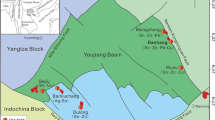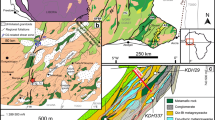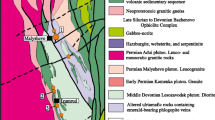Abstract
The Longtoushan hydrothermal gold deposit is located in the southwestern region of the Dayaoshan Uplift. Tourmaline is widespread in the Longtoushan gold deposit and is mainly distributed in the rhyolite porphyry and associated cryptoexplosive breccia. The spatial distribution of tourmaline enrichment is similar to that of the gold orebody. Feldspar has been largely replaced by tourmaline in the rhyolite porphyry and cryptoexplosive breccia. Electron microprobe analysis revealed that tourmalines in the Longtoushan deposit belong mainly to the alkali group and partly to the X-vacant group; they mostly fell in the schorl-dravite series field. Two distinct sets of dominant substitutions were observed: MgFe−1 and Al□(NaR2+)−1, where R = Fe, Mg. In addition, minor substitutions include (CaMg)(NaAl)−1 and FeAl−1. The calculated δ11B value for the mineralizing fluids ranged from − 12.8 to − 9.7‰, which is typical of S-type granites, and boron-enriched fluids predominantly derived from rhyolitic melt. Part of the tourmaline from the rhyolite porphyry crystallized during the magmatic-hydrothermal stage, whereas most tourmalines from the deposit formed in the post-magmatic hydrothermal stage. The tourmalines were deposited from a relatively reduced and acidic fluid system, and the gold predominantly precipitated during the post-magmatic hydrothermal stage in the Longtoushan deposit.

Modified after Chen et al. (2015)

a is modified after Xie and Sun (1993)







Similar content being viewed by others
References
Bureau of Geology and Mineral Resources of Guangxi Zhuang Autonomous Region (1985) Regional geology of Guangxi Zhuang Autonomous Region. Geological Publishing House, Beijing (in Chinese)
Chen MH, Li ZY, Li Q et al (2015) A preliminary study of multi-stage granitoids and related metallogenic series in Dayaoshan area of Guangxi, China. Earth Sci Front 22:41–53. https://doi.org/10.13745/j.esf.2015.02.004 (in Chinese with English abstract)
Chen FW, Li HQ, Mei YP (2008) Zircon SHRIMP U-Pb chronology of diagenetic mineralization of the Longtoushan porphyry gold orefield, Gui County, Guangxi. Acta Geol Sin (Chin Ed) 82:921–926 (in Chinese with English abstract)
Codeço MS, Weis P, Trumbull RB et al (2017) Chemical and boron isotopic composition of hydrothermal tourmaline from the Panasqueira W–Sn–Cu deposit, Portugal. Chem Geol 468:1–16. https://doi.org/10.1016/j.chemgeo.2017.07.011
Duan RC, Ling WL, Li Q et al (2011) Correlations of the late Yanshanian Tectonomagmatic events with metallogenesis in South China: geochemical constraints from the Longtoushan gold ore deposit of the Dayaoshan area, Guangxi Province. Acta Geol Sin (Chin Ed) 85:1644–1658 (in Chinese with English abstract)
Dutrow BL, Henry DJ (2011) Tourmaline: a geologic DVD. Elements 7:301–306. https://doi.org/10.2113/gselements.7.5.301
Goerne GV, Franz G, Heinrich W (2001) Synthesis of tourmaline solid solutions in the system Na2O–MgO–Al2O3–SiO2–B2O3–H2O–HCl and the distribution of Na between tourmaline and fluid at 300 to 700 °C and 200 MPa. Contrib Mineral Petrol 141:160–173. https://doi.org/10.1007/s004100100243
Henry DJ, Dutrow BL (1996) Metamorphic tourmaline and its petrologic applications. In: Grew ES, Anovitz LN (eds) Boron: mineralogy, petrology, and geochemistry, vol 33. Mineralogical Society of America, Chantilly, pp 503–557
Henry DJ, Guidotti CV (1985) Tourmaline as a petrogenetic indicator mineral: an example from the staurolite-grade metapelites of NW Maine. Am Mineral 70:1–15
Henry DJ, Novák M, Hawthorne FC et al (2011) Nomenclature of the tourmaline-supergroup minerals. Am Mineral 96:895–913. https://doi.org/10.2138/am.2011.3636
Hervig RL, Moore GM, Williams LB et al (2002) Isotopic and elemental partitioning of boron between hydrous fluid and silicate melt. Am Mineral 87:769–774
Hinsberg VJV, Henry DJ, Marschall HR (2011) Tourmaline: an ideal indicator of its host environment. Can Mineral 49:1–16. https://doi.org/10.3749/canmin.49.1.1
Hou KJ, Li YH, Xiao YK, Tian YR (2010) In situ boron isotope measurements of natural geological materials by LA-MC-ICP-MS. Chin Sci Bull 55:3305–3311 (in Chinese with English abstract)
Huang MZ, Chen WS, Li WZ et al (1999) Longtoushan gold deposit of subvolcanic-cryptoexplosion breccia type, Guangxi. Acta Geosci Sin 20:39–46 (in Chinese with English abstract)
Huang HM, He ZJ, Cui B (2003) Metallogenic series of granite in Dayaoshan of Guangxi. Geol Prospect 39:12–16 (in Chinese with English abstract)
Huang XY, Zhang H, Tang Y, Guan SJ (2008) Chemical composition of tourmalines from the B-rich granite and miarolitic cavities in Yinping, Guangxi and its implications for evolution of the magmatic-hydrothermal system. Acta Mineral Sin 28:25–34. https://doi.org/10.16461/j.cnki.1000-4734.2008.01.003 (in Chinese with English abstract)
Jiang SY, Palmer MR, Slack JF, Shaw DR (1999) Boron isotope systematics of tourmaline formation in the Sullivan Pb–Zn–Ag deposit, British Columbia, Canada. Chem Geol 158:131–144. https://doi.org/10.1016/S0009-2541(99)00023-6
Lu ZL (2008) Chinese tourmaline deposits’ types with their geological characteristics. Miner Resour Geol 22:174–178 (in Chinese with English abstract)
Mao JW, Chen MH, Yuan SD, Guo CL (2011) Geological characteristics of the Qinhang (or Shihang) metallogenic belt in South China and spatial-temporal distribution regularity of mineral deposits. Acta Geol Sin 85:636–658 (in Chinese with English abstract)
Marschall HR, Korsakov AV, Luvizotto GL et al (2009) On the occurrence and boron isotopic composition of tourmaline in (ultra) high-pressure metamorphic rocks. J Geol Soc Lond 166:811–823. https://doi.org/10.1144/0016-76492008-042
Meyer C, Wunder B, Meixner A et al (2008) Boron-isotope fractionation between tourmaline and fluid: an experimental re-investigation. Contrib Mineral Petrol 156:259–267. https://doi.org/10.1007/s00410-008-0285-1
Mlynarczyk MSJ, Williams-Jones AE (2006) Zoned tourmaline associated with cassiterite: implications for fluid evolution and tin mineralization in the San Rafael Sn–Cu deposit, southeastern Peru. Can Mineral 44:347–365. https://doi.org/10.2113/gscanmin.44.2.347
Morgan GB, London D (1989) Experimental reactions of amphibolite with boron-bearing aqueous fluids at 200 MPa: implications for tourmaline stability and partial melting in mafic rocks. Contrib Mineral Petrol 102:281–297
Novák M, Skoda R, Filip J et al (2011) Compositional trends in tourmaline from intragranitic NYF pegmatites of the trebic pluton, Czech Republic: an electron microprobe, Mossbauer and LA-ICP-MS study. Can Mineral 49:359–380. https://doi.org/10.3749/canmin.49.1.359
Palmer MR, Slack JF (1989) Boron isotopic composition of tourmaline from massive sulphide deposit and tourmalinites. Contrib Mineral Petrol 103:434–451
Slack JF (1996) Tourmaline associations with hydrothermal ore deposites. Rev Mineral Geochem 33:559–643
Slack JF, Coad PR (1989) Multiple hydrothermal and metamorphic events in the Kidd Creek volcanogenic massive sulphide deposit, Timmins, Ontario: evidence from tourmalines and chlorites. Can J Earth Sci 26:694–715. https://doi.org/10.1139/e89-059
Slack JF, Trumbull RB (2011) Tourmaline as a recorder of ore-forming processes. Elements 7:321–326. https://doi.org/10.2113/gselements.7.5.321
Tao SL, Lai JQ, Zhang JD et al (2017) Geochemical characteristics of auriferous pyrite in Longtoushan gold deposit, Guangxi Province, China. Chin J Nonferrous Met 27:1263–1279. https://doi.org/10.19476/j.ysxb.1004.0609.2017.06.022 (in Chinese with English abstract)
Tonarini S, Pennisi M, Adorni-Braccesi A et al (2003) Intercomparison of boron isotope and concentration measurements. Part I: section, preparation and homogeneity tests of the intercomparison materials. Geostand Geoanal Res 27:21–29. https://doi.org/10.1111/j.1751-908X.2003.tb00710.x
Trumbull RB, Slack JF, Krienitz M-S et al (2011) Fluid sources and metallogenesis in the Blackbird Co–Cu–Au–Bi–Y–REE district, Idaho, U.S.A.: insights from major-element and boron isotopic compositions of tourmaline. Can Mineral 49:225–244. https://doi.org/10.3749/canmin.49.1.225
Trumbull RB, Slack JF (2018) Boron isotopes in the continental crust: granites, pegmatites, felsic volcanic rocks, and related ore deposits. In: Marschall HR, Foster GL (eds) Boron isotopes: the fifth element (advances in isotope geochemistry). Springer, Berlin
Wang CH (2011) Metallogenic model and prognosis of the Longtoushan gold field, the Guangxi Zhuang Autonomous Region, China. Dissertation, Chinese Academy of Geological Sciences (in Chinese)
Williams-Jones AE, Bowell RJ, Migdisov AA (2009) Gold in solution. Elements 5:281–287. https://doi.org/10.2113/gselements.5.5.281
Xie LS, Sun BD (1993) Geological characteristics of Longtoushan volcanic–subvolcanic gold deposit, Guigang City, Guangxi. Geol Guangxi 6:27–42 (in Chinese with English abstract)
Xiong X, Xu WY, Lv QT et al (2014) Tourmaline as an early stage indicator of uranium mineralization in the deep drilling, Luzong Basin, Anhui Province. Acta Petrol Mineral 33:263–272 (in Chinese with English abstract)
Yang SY, Jiang SY, Palmer MR (2015) Chemical and boron isotopic compositions of tourmaline from the nyalam leucogranites, south Tibetan Himalaya: implication for their formation from B-rich melt to hydrothermal fluids. Chem Geol 419:102–113
Yang GG, Zhu WF, Zhang F (2008) Multistage ore-forming process and distributing characteristics of Au, Ag elements in the Longtoushan gold deposit, Guangxi. Miner Resour Geol 22:437–440 (in Chinese with English abstract)
Zhou YZ, Zeng CY, Li HZ et al (2012) Geological evolution and ore-prospecting targets in southern segment of Qinzhou Bay–Hangzhou Bay juncture orogenic belt, southern China. Geol Bull China 31:486–491 (in Chinese with English abstract)
Zhu GT (2002) Study on geological character and genesis of Longtoushan gold deposit of Guangxi. Miner Resour Geol 16:266–272 (in Chinese with English abstract)
Acknowledgements
This study was supported by the Project of Innovation-driven Plan in Central South University (Project No. 2015CX008) and the Fundamental Research Funds for the Central Universities of Central South University (Project No. 2015zzts071). Miao Yu and Jeff Dick are thanked for their critical review of the manuscript. Moreover, we wish to thank two anonymous reviewers and editors for their constructive comments.
Author information
Authors and Affiliations
Corresponding author
Rights and permissions
About this article
Cite this article
Qian, L., Lai, J., Zhang, S. et al. Chemical and boron isotopic compositions of tourmaline in the Longtoushan hydrothermal gold deposit, Guangxi, China: implications for gold mineralization. Acta Geochim 38, 277–291 (2019). https://doi.org/10.1007/s11631-018-0292-5
Received:
Revised:
Accepted:
Published:
Issue Date:
DOI: https://doi.org/10.1007/s11631-018-0292-5




